Discover the delightful flavours of Greek bread, aka "horiatiko psomi". This easy Greek village bread recipe uses simple ingredients and creates a rustic loaf with a soft crumb and crisp crust.

CONTENTS
What is "Horiatiko Psomi"?
Horiatiko psomi, which translates to "village bread" or "country bread", is a staple in Greek cuisine and is made with simple ingredients such as flour, water, yeast, and salt. It is traditionally baked in wood-fired ovens, giving it a unique and distinctive sourdough flavour. The crust is usually rustic and golden brown, while the inside remains soft and airy.
Why this recipe works
- It's easy. Only a few simple ingredients are required to make this traditional Greek bread, and most of these are probably in your pantry right now! It follows the "no knead" technique, so you'll only be using one bowl (leave the dough hook on your expensive stand mixer for another time!).
- It's incredibly versatile. Serve it alongside some tzatziki, dip into a Greek lettuce salad or enjoy it on its own with a drizzle of olive oil -it's a real winner!
- It's traditional. Nothing beats traditional humble recipes with cultural significance - Greek bread is a staple served nearly every meal! Trust me! I've eaten at many Greek households, and it is a must! 🙂
🥖If you're interested, I have more Greek bread recipes for you - my Greek Easter bread (tsoureki) is a specialty that beats brioche in taste and texture. My Greek flatbread - "lagana" is soft, chewy and drenched in sesame seeds. And let's not forget my Greek yogurt flatbread - 2 ingredients, and you have the tastiest Greek pita bread in no time!
Ingredients
Here are the key ingredients you'll need to make this easy Greek bread recipe:

Ingredient Notes
- Bread flour: I recommend strong white bread flour for this recipe. Sub with regular all-purpose or plain flour if you can't source any.
- Rye flour: I love the addition of this ingredient in this recipe. It adds earthiness and gives this homemade bread a little extra colour. You can sub with whole wheat flour.
- Semolina flour: The addition of fine semolina is entirely optional. However, throughout the recipe testing process, I found it added a little extra density to this rustic bread. Semolina is mainly used in Greek desserts (like my galatopita) - if you don't have any on hand, just sub with regular all-purpose flour.
- Dry yeast: Use the "instant" kind.
- Water: To help bring the dough together. The water should be warm, not hot.
- Sugar: Sugar is optional - I like to add it for balance.
- Salt: Don't skip this ingredient! Salt adds flavour to bread - trust me!
- Optional: Add some sesame seeds for a little extra flavour and crunch!
How to make Greek bread
For the full recipe, see the instruction card below. The pictures below cover the basic steps of mixing, shaping and baking. Please watch the video as well!

(1) Combine the bread flour, rye flour, semolina, dried yeast, sugar and salt in a large mixing bowl and stir to combine.
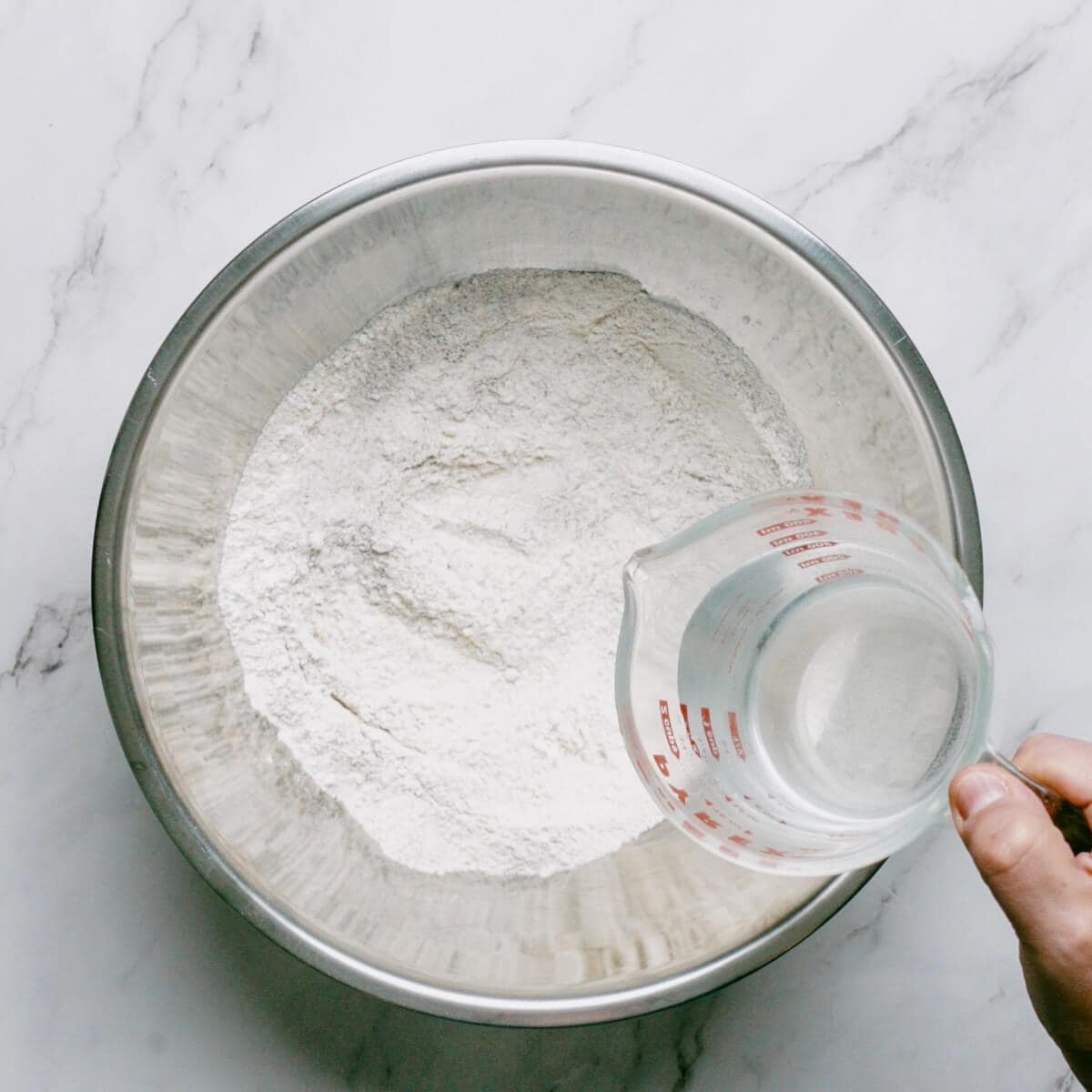
(2) Gradually add the water to the flour and yeast mixture and stir until you have a shaggy, rough dough. Cover with a kitchen towel and allow the dough to rest for 15 minutes.

(3) Using a spatula or wooden spoon, gradually pull the dough from the sides of the bowl to the centre. Cover again, let it rest for fifteen minutes and repeat this step three more times.
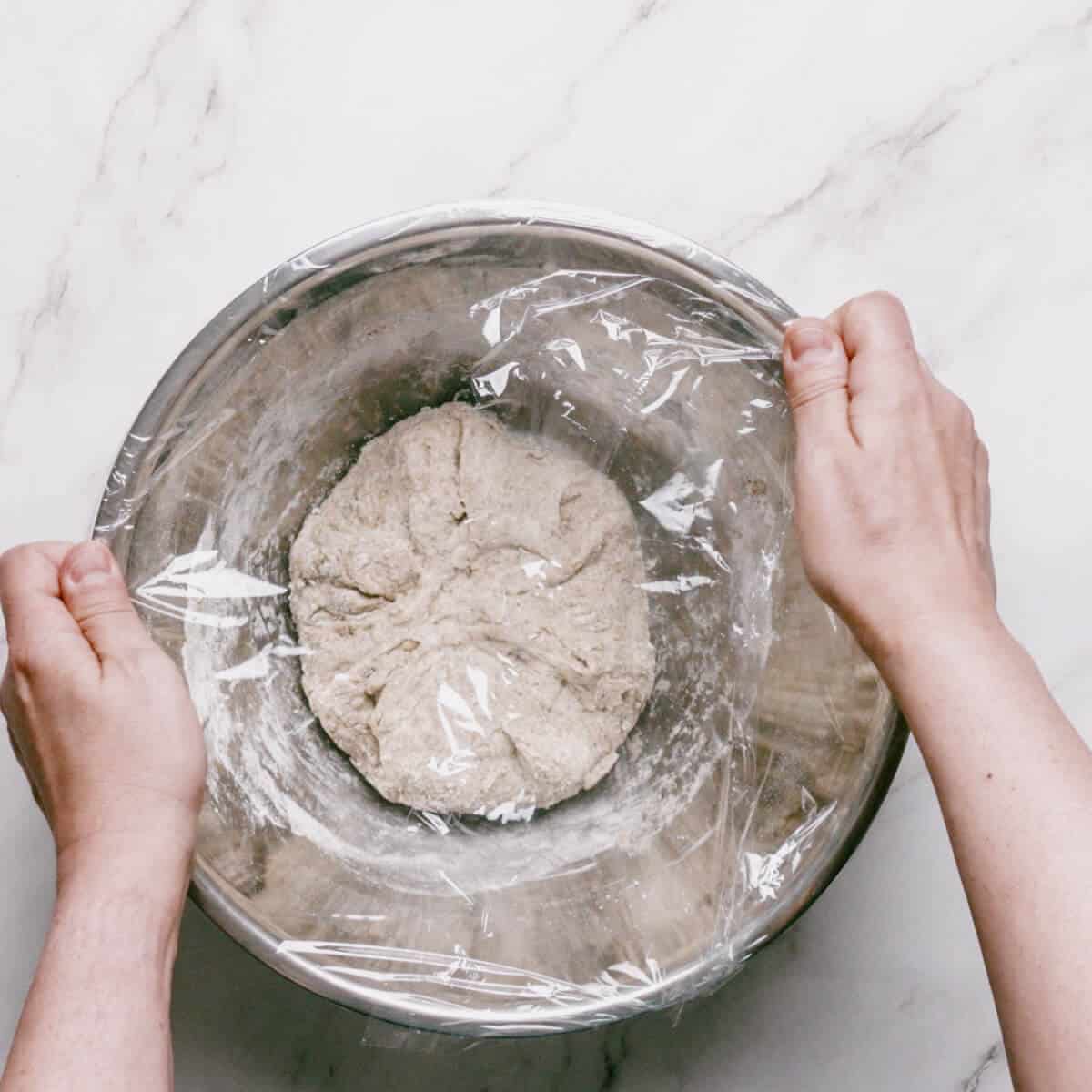
(4) Cover the dough in plastic wrap (cling film) and leave the dough to rise for 4 - 24 hours.
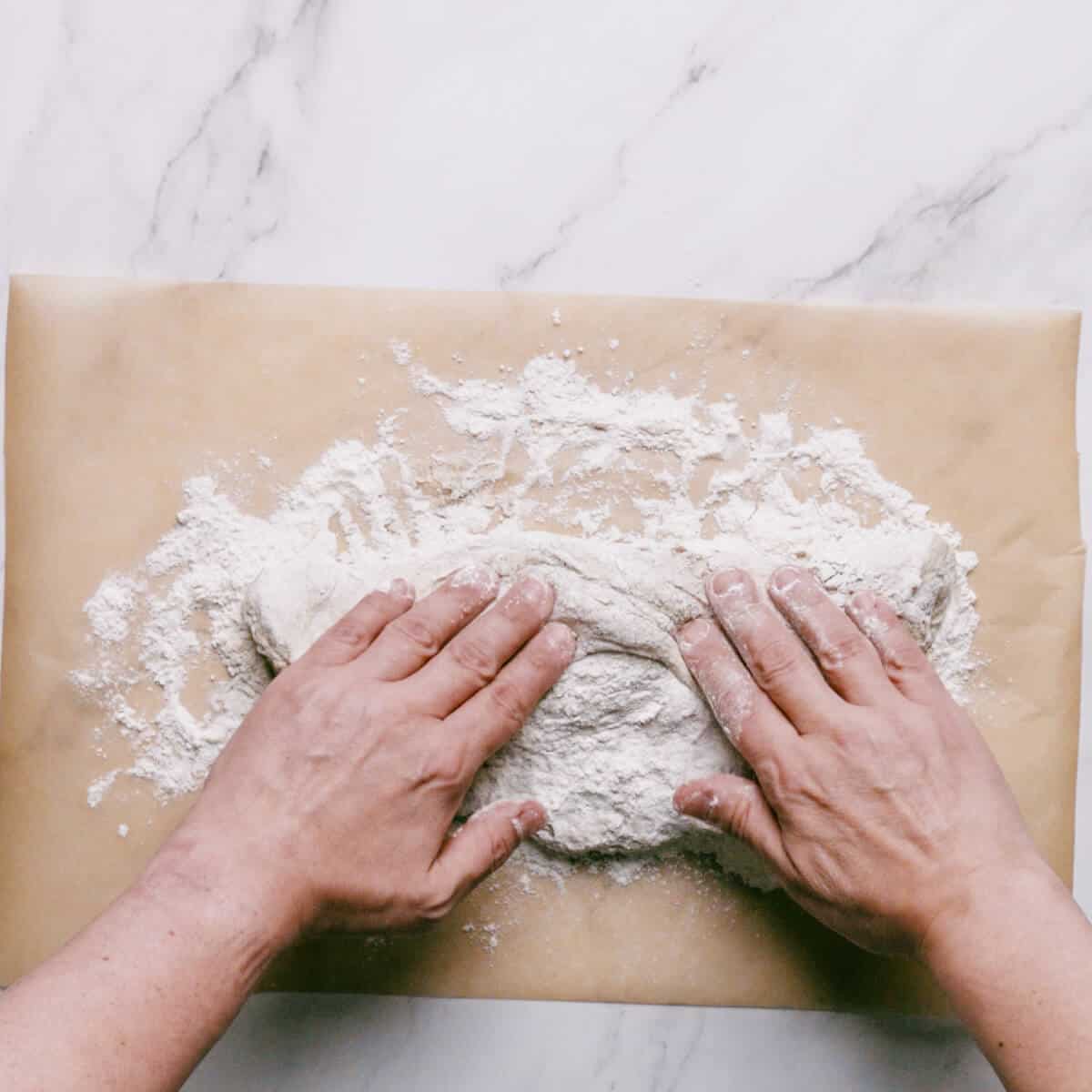
(5) Transfer the dough to a clean, lightly floured surface, gently knead it, and stretch it to resemble a rectangle.
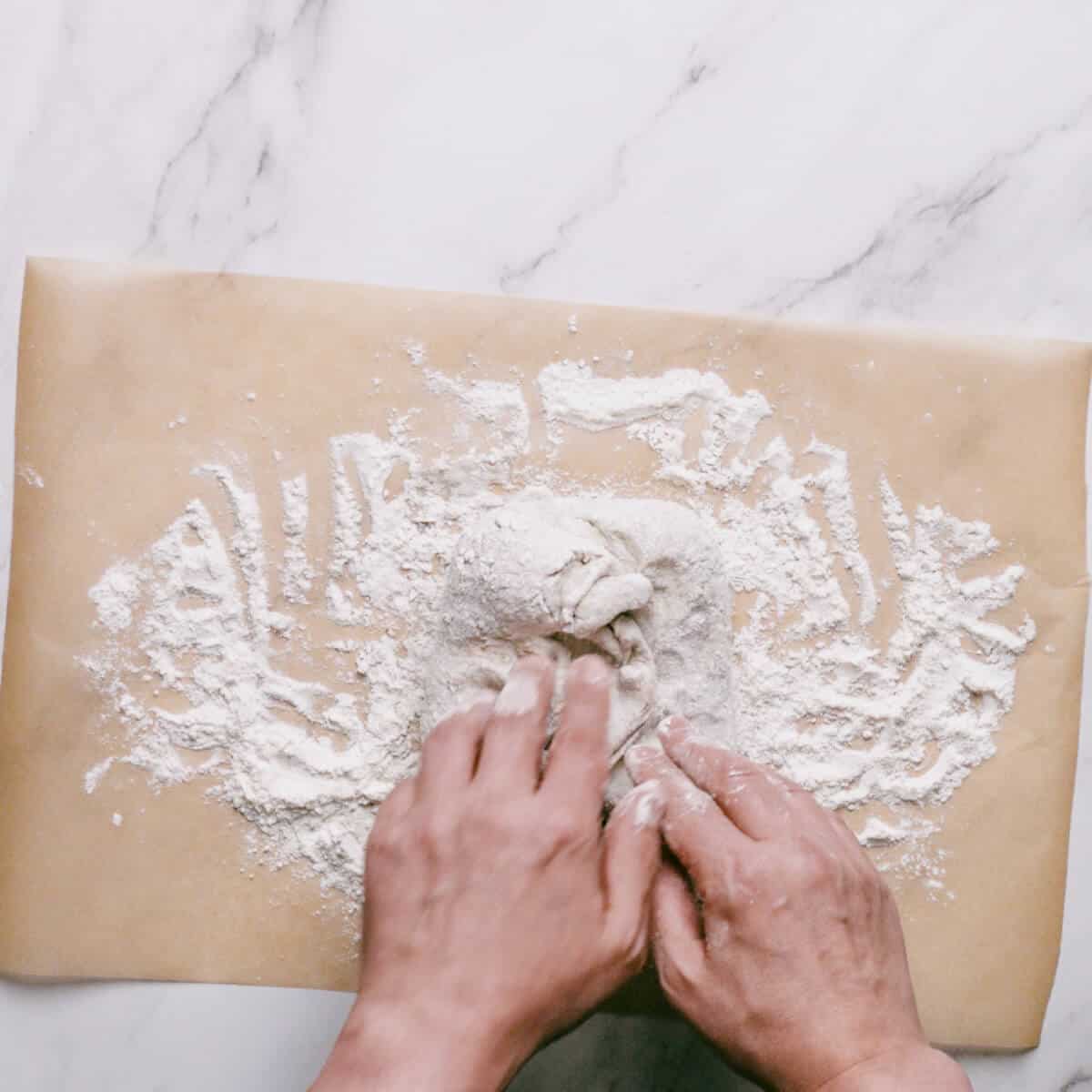
(6) With the longer edge facing you, fold the longer sides into the centre and the shorter ends into the centre.

(7) Using your hands, shape the dough into a round ball.
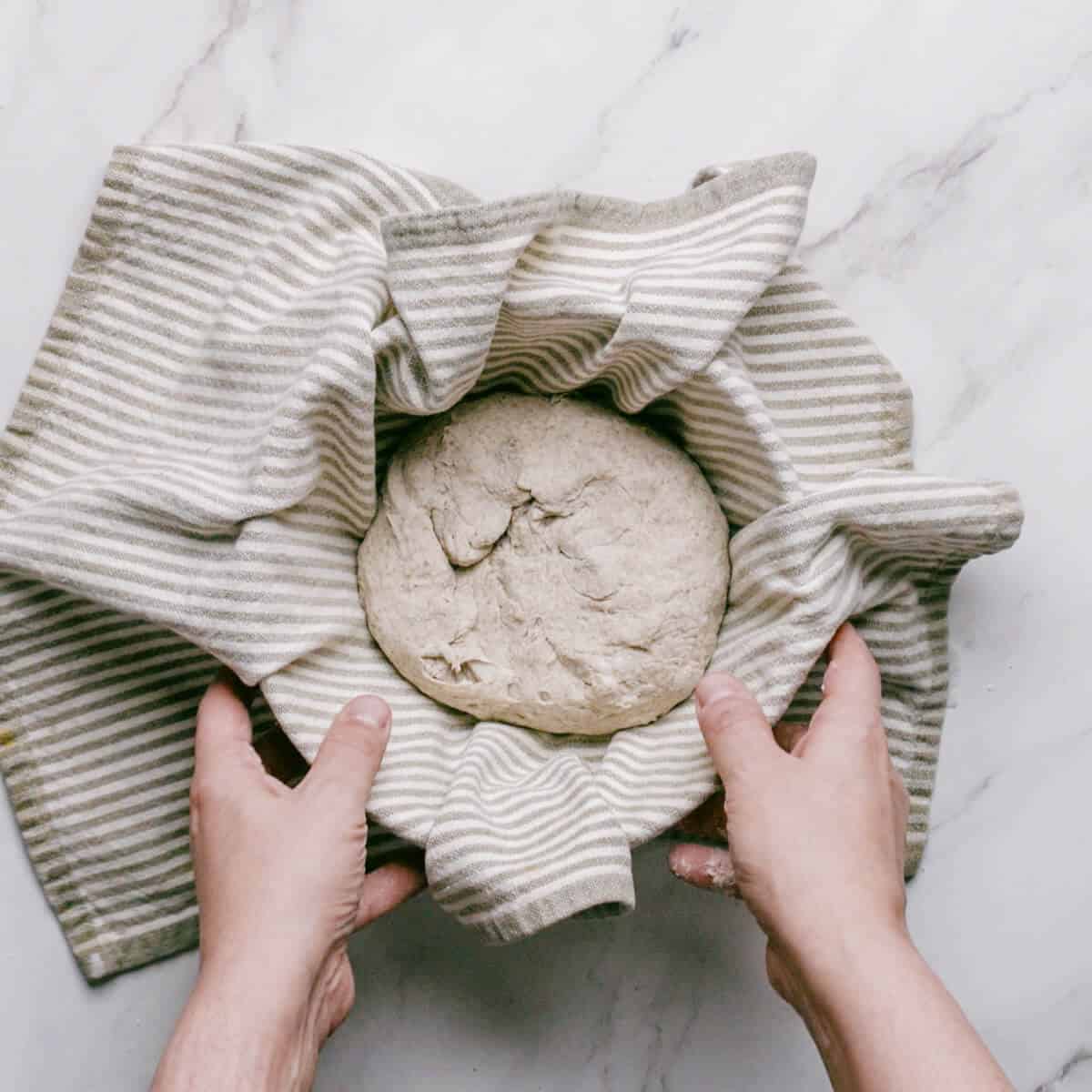
(8) Place the dough ball into a bowl lined with a clean towel. Cover and let it rest for a second time until it doubles in size. (this could take anywhere between 60-90 minutes).

(9) Preheat your oven to 230°C (450°F) and place an oven-safe pot with a lid to heat up for 30 minutes.
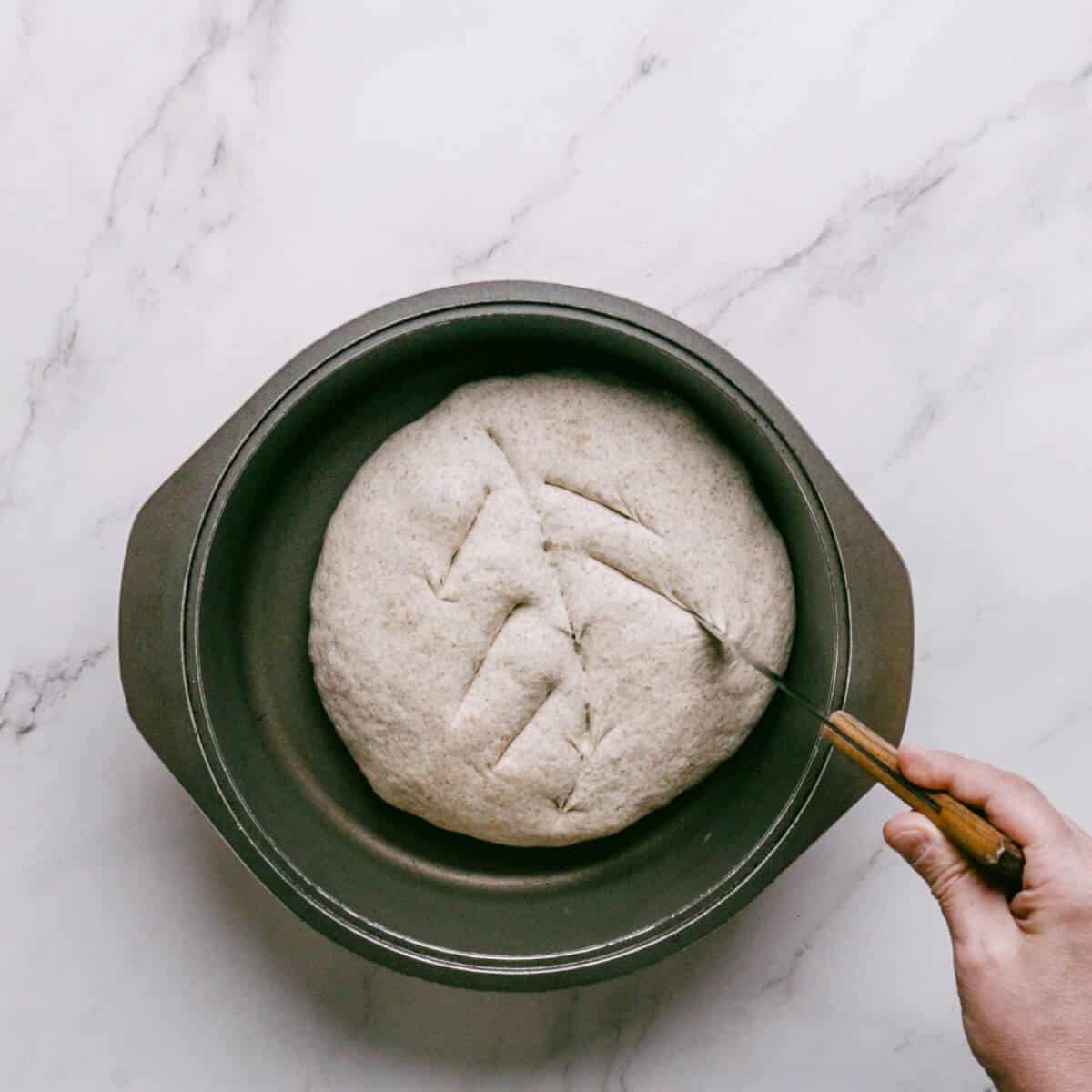
(10) Once heated place the dough into it. You can score at the top if you like. Place the lid back on and bake for 30 minutes.
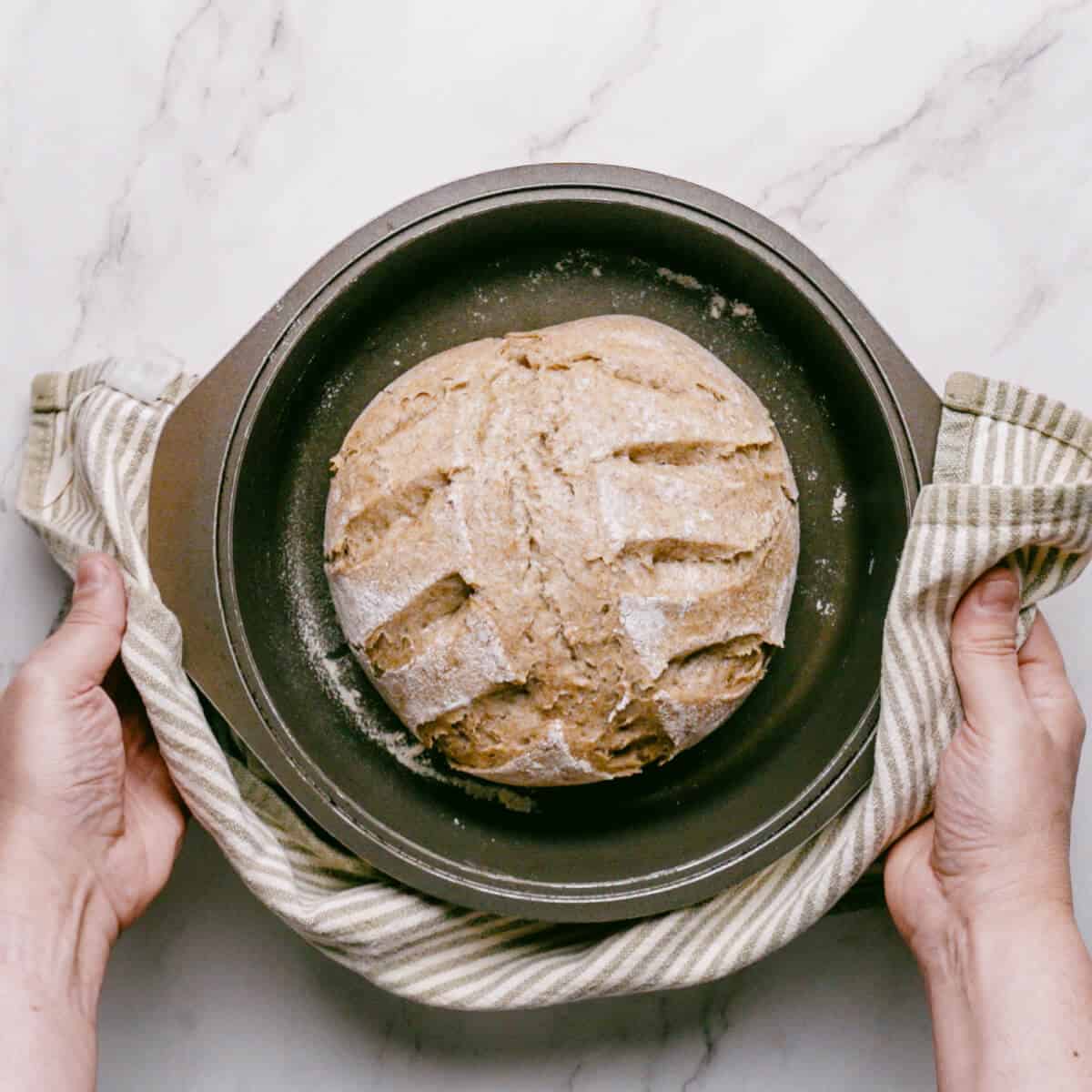
(11) Very carefully remove the lid ( you will notice the bread is partially baked and pale in colour - don't panic! That's normal!). Drop the temperature to 220°C (430°F) and bake for 20 minutes.
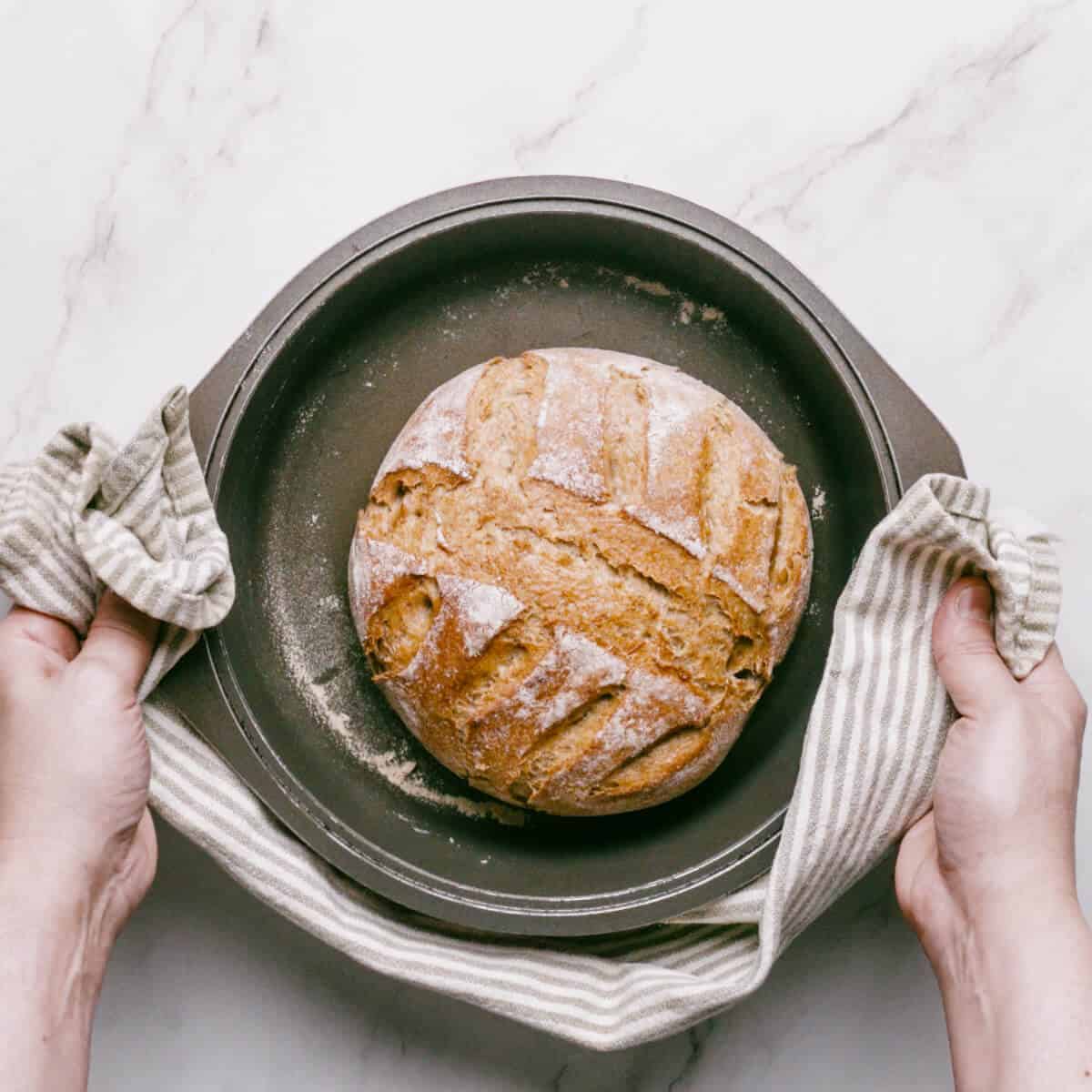
(12) Remove the pot from the oven (the bread should be golden brown) and allow it to cool completely before serving.
Expert tips & FAQ
- Don't stress if you can't use bread flour to make this recipe. While it does help with the loaf's structure, I have made it numerous times with regular all-purpose flour and achieved excellent results.
- If you prefer a stand mixer with a dough hook - that's okay too. However, with this type of bread - it's best to use your hands to get a "feel" for the dough. It's based on the "no-knead" style of bread making, so a fancy machine isn't necessary! Plus, it's fun to get your hands dirty!
- Add a tablespoon of olive oil to the bread dough if it's dry - but don't overdo it! A little olive oil goes a long way, and it also helps with producing a softer crumb.
- Rest the dough. It's essential to allow the dough to rest before baking. It helps the gluten "relax" and makes it easier to shape the dough. If you plan on baking the bread the following day - rest the dough in the fridge - this will allow the flavours to ferment - giving it an almost sourdough-like taste. Ensure the dough has come to room temperature before shaping and baking.
- Flour your surface with enough flour to shape the dough. Avoid using excess flour.
- Use a proper pot to make this bread. A Dutch oven is preferable. However, a ceramic or stainless steel pot works wonders, too. Just make sure it's oven-safe, and that includes the lid. Avoid using aluminium pots!
- If you prefer, you can bake this bread without a pot. Ensure your oven is hot, and shape the dough into your desired shape. Place it on a parchment paper lined baking sheet and bake for 40 minutes until browned on top. Allow to cool before serving.
- Tap the bottom of your bread when it has finished cooking. If you hear a hollow sound, you know it's done.
Greek Bread is also known as horiatiko bread or psomi spitiko.
Yes, you can use a bread machine to make this bread. Follow the instructions of your specific bread machine. However, be mindful that it will form the shape of the bread machine's baking tin.
Storing & freezing
- If you want to enjoy this delicious bread - store it in a plastic bag at room temperature for up to one week. However, for best results, store it in the refrigerator.
- If freezing - slice it and toast the bread from frozen (no need to thaw it first).
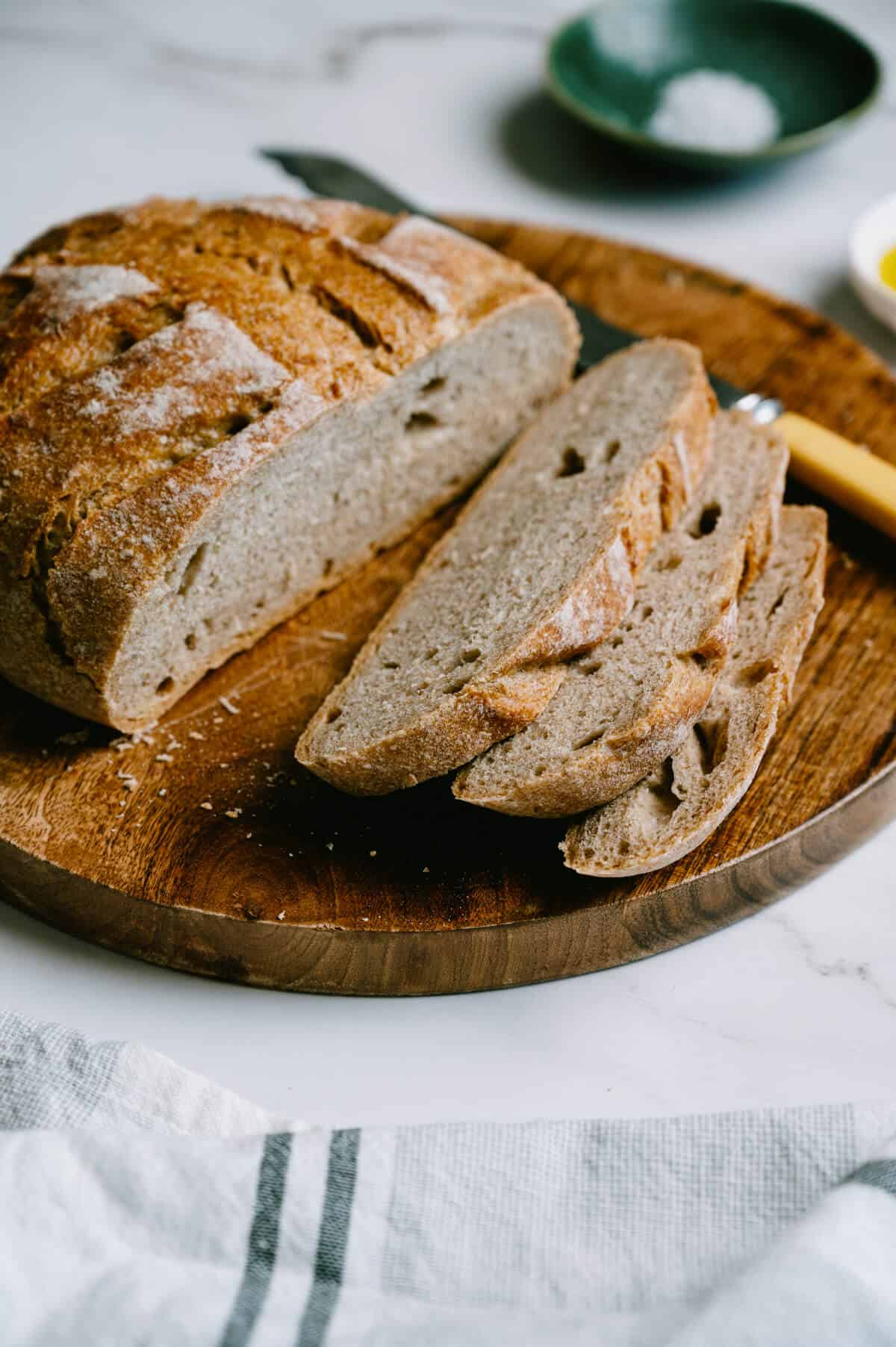
Video
More bread recipes
If you've made this recipe or any other recipe on the blog - don't forget to rate it and leave a comment below. You can also follow the blog on Facebook, Instagram and Pinterest OR sign up to the Newsletter for the latest delicious recipes.
📋 Recipe
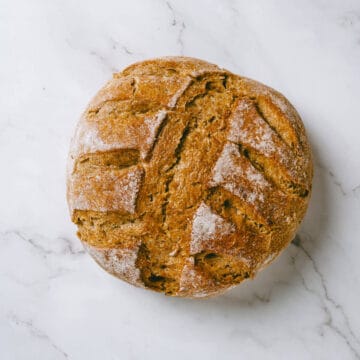
Greek Bread Recipe (Horiatiko Psomi)
Ingredients
- 200 grams bread flour, (see note 1)
- 100 grams rye flour, (see note 2)
- 100 grams semolina flour, (see note 3)
- 2 grams dried yeast, the instant type
- 1 tsp sugar, granulated
- 300 ml water, tepid or lukewarm
Instructions
- Combine the bread flour, rye flour, semolina, dried yeast, sugar and salt in a large mixing bowl and stir to combine. (see note 4)200 grams bread flour, 100 grams rye flour, 100 grams semolina flour, 2 grams dried yeast, 1 teaspoon sugar, 300 ml water
- Gradually add the water to the flour and yeast mixture and stir until you have a shaggy, rough dough.
- Cover with a kitchen towel and allow the dough to rest for 15 minutes.
- Using a spatula or wooden spoon, gradually pull the dough from the sides of the bowl to the centre.
- Cover again, let it rest for fifteen minutes and repeat this step three more times.
- Cover the dough in plastic wrap (cling film) and leave the dough to rise for 4 - 24 hours. (see note 5)
- Transfer the dough to a clean, lightly floured surface, gently knead it, and stretch it to resemble a rectangle. (see note 6)
- With the longer edge facing you, fold the longer sides into the centre and the shorter ends into the centre (repeat this step twice).
- Using your hands, shape the dough into a round ball.
- Place the dough ball into a bowl lined with a clean towel. Cover and let it rest for a second time until it doubles in size. (this could take anywhere between 60-90 minutes).
- Preheat your oven to 230°C (450°F) and place an oven-safe pot with a lid to heat up for 30 minutes. A Dutch oven is perfect for this recipe! (see notes 7&8)
- Remove the preheated Dutch oven and place the dough into it. You can score at the top if you like. Place the lid back on and bake for 30 minutes.
- Very carefully remove the lid ( you will notice the bread is partially baked and pale in colour - don't panic! That's normal!). Drop the temperature to 220°C (430°F) and bake for a further 20 minutes.
- Remove the bread from the oven (it should be golden brown) and allow it to cool completely before serving. (see note 9)
Notes
- I recommend strong white bread flour for this recipe. Sub with regular all-purpose or plain flour if you can't source any.
- Sub with whole wheat flour if you don't have any.
- Sub with all-purpose flour if you can't use semolina.
- If you prefer a stand mixer with a dough hook - that's okay too. However, with this type of bread - it's best to use your hands to get a "feel" for the dough. It's based on the "no-knead" style of bread making, so a fancy machine isn't necessary! Plus, it's fun to get your hands dirty!
- Rest the dough. It's essential to allow the dough to rest before baking. It helps the gluten "relax" and makes it easier to shape the dough. If you plan on baking the bread the following day - rest the dough in the fridge - this will allow the flavours to ferment - giving it an almost sourdough-like taste. Ensure the dough has come to room temperature before shaping and baking.
- Flour your surface with enough flour to shape the dough. Avoid using excess flour.
- Use a proper pot to make this bread. A Dutch oven is preferable. However, a ceramic or stainless steel pot works wonders, too. Just make sure it's oven-safe, and that includes the lid. Avoid using aluminium pots!
- If you prefer, you can bake this bread without a pot. Ensure your oven is hot, and shape the dough into your desired shape. Place it on a parchment paper lined baking sheet and bake for 40 minutes until browned on top. Allow to cool before serving.
- Tap the bottom of your bread when it has finished cooking. If you hear a hollow sound, you know it's done.
Nutrition
This website provides approximate nutrition information for convenience and as a courtesy only. Nutrition data is gathered primarily from the USDA Food Composition Database, whenever available, or otherwise other online calculators.
© Souvlaki For the Soul


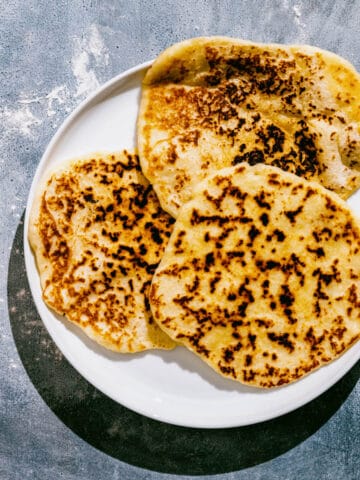
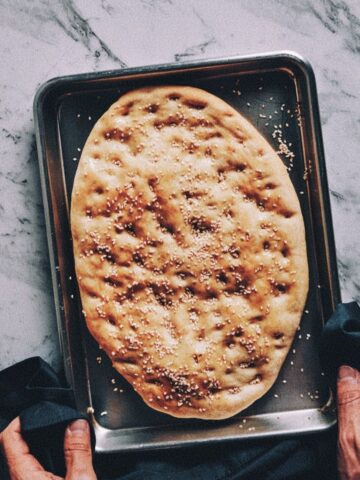
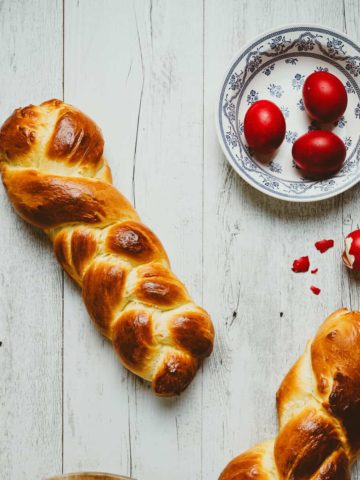
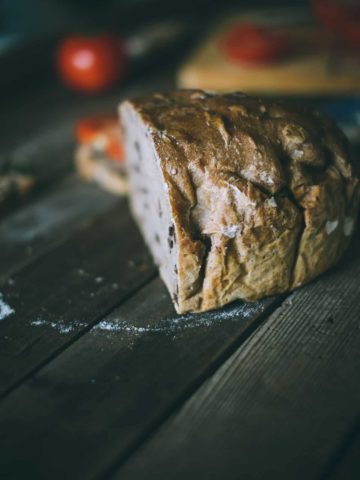
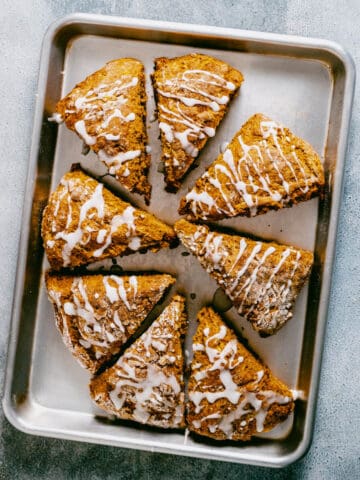
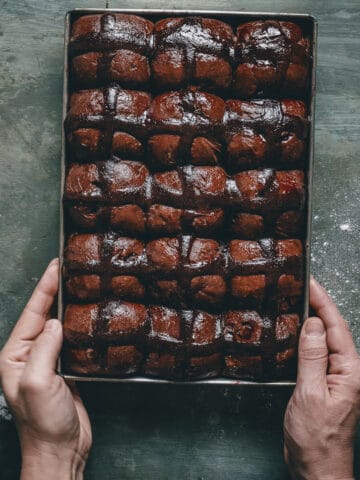
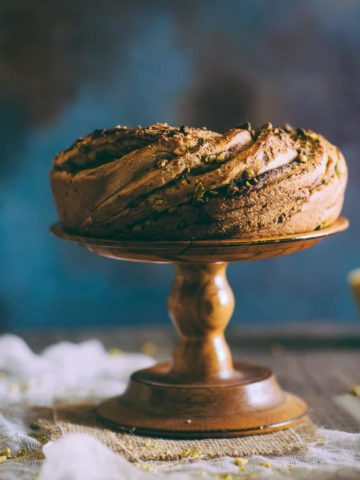
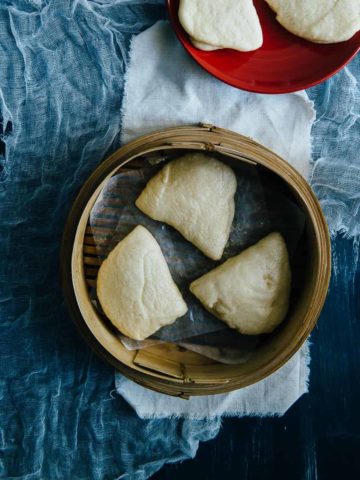
Leave a Reply